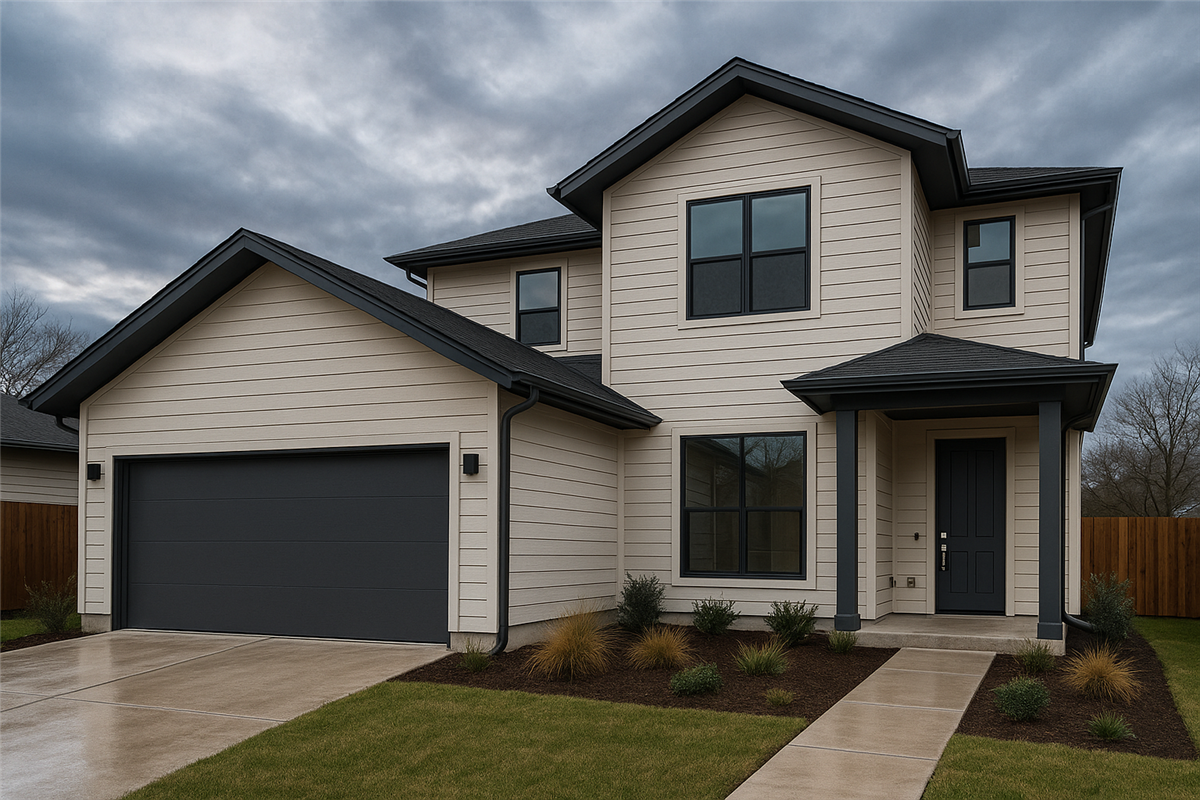With over 8 million American homes currently sporting James Hardie siding, a trend that increases yearly, it's clear homeowners are recognizing its numerous benefits - including unparalleled durability, stunning aesthetics, and robust weather resistance. In this blog post, we delve deep into James Hardie Siding installation, offering you key tips and industry-standard best practices to ensure your home not only looks impressive but stands the test of time too. So why settle for a mediocre exterior when the perfect blend of beauty and brawn is at your fingertips? Stay tuned to deck your house in award-winning armor!
James Hardie Siding Installation Overview
When it comes to siding options, James Hardie stands out as a trusted and reputable brand. Known for its durability, versatility, and aesthetic appeal, James Hardie siding installation is a popular choice among homeowners. This fiber cement siding offers exceptional resistance to factors such as weather, pests, and fire – making it an excellent long-term investment for your home.
The installation process of James Hardie siding involves several key steps to ensure a proper and durable outcome. From preparing the surface to securing the siding in place, each stage contributes to the overall quality of the installation.
Firstly, surface preparation is crucial. The existing exterior should be thoroughly inspected for any damage or rotting areas. These issues must be addressed before installation begins to prevent further complications down the line. The surface should also be cleaned and free from any debris or contaminants that may affect adhesion.
Next, the flashing system is installed. Flashing plays a vital role in preventing water infiltration behind the siding and is essential for protecting vulnerable areas, such as windows, doors, and corners. Properly installed flashings create a barrier against moisture and contribute to the longevity of your siding.
Once the flashing system is in place, the weather-resistant barrier or house wrap is applied. This acts as an added layer of protection against moisture intrusion and helps enhance energy efficiency. It's important to follow manufacturer guidelines when installing this barrier to ensure its effectiveness.
After the weather-resistant barrier is installed, it's time for the actual Hardie siding installation. Each piece of James Hardie siding should be carefully measured, cut to size, and securely attached using appropriate fasteners recommended by the manufacturer. Following proper nailing patterns helps ensure structural integrity and prevents future issues like warping or buckling.
Pre-Installation Tips for James Hardie Siding Installation
Preparing for a James Hardie siding installation involves a few critical steps that can help ensure the best possible outcome and maximize the longevity of your siding.
One of the first things to consider is choosing the right contractor. Proper installation is crucial for the performance and durability of your siding. Look for a contractor with experience in James Hardie siding installation, preferably one who holds certifications from the manufacturer. A qualified professional will be well-versed in best practices and can guide you through the entire process.
For instance, hiring a contractor who has achieved the James Hardie Elite Preferred Contractor designation ensures that they have received specialized training and demonstrated excellence in their craft.
Another important aspect to address is proper ventilation. Adequate airflow behind your siding helps prevent moisture buildup and potential issues such as mold or rot. Ensure that your contractor incorporates proper ventilation measures into the installation, including vented soffits or other recommended methods specific to your home's design.
Additionally, take time to select the right type and style of James Hardie siding installation that suits both your personal preferences and the architectural elements of your home. With various options available, such as lap siding, shingles, and vertical panels, choose one that not only enhances curb appeal but also aligns with regional climate considerations.
Finally, it is essential to discuss warranty coverage with your contractor before proceeding with installation. Understanding the terms and conditions of the warranty provides peace of mind and ensures that you are aware of any necessary maintenance requirements or limitations regarding product performance.
Remember, proper planning and attention to detail during this pre-installation phase will set the stage for a successful and long-lasting James Hardie siding installation.
Old Siding Removal and Inspection
Before the James Hardie siding installation, it is crucial to properly remove the old siding and conduct a thorough inspection of the underlying structure. This critical step ensures a smooth installation process and guarantees the longevity and durability of your new siding.
Start by assessing the condition of your existing siding. Look for signs of damage such as cracks, rot, or pest infestations. Inspect the sheathing beneath the siding for any signs of moisture damage or structural issues. It is essential to address these issues before proceeding with the installation to prevent further damage.
For instance, if you notice rot in certain areas, it would be wise to replace those sections of sheathing to provide a solid foundation for your new siding. Ignoring these underlying issues can lead to costly repairs down the line.
Next, carefully remove the old siding using appropriate tools and techniques. Take care not to damage the sheathing during this process. Pay particular attention to corners and edges where water intrusion may have occurred.
Once the old siding is removed, thoroughly inspect the sheathing for any signs of moisture damage or other structural concerns. Address any issues found before proceeding to ensure a stable and secure surface for your new James Hardie siding.
Steps to Installing James Hardie Siding
Installing James Hardie siding requires careful attention to detail and adherence to best practices. Follow these steps to ensure a successful installation:
- Prepare the Surface: Clean the sheathing and remove any debris or contaminants that may interfere with proper adhesion. Ensure that all moisture issues have been resolved before proceeding.
- Flashing Installation: Install appropriate flashing around windows, doors, and other openings to prevent water intrusion. Proper flashing is crucial for maintaining the integrity of your siding and protecting against moisture damage.
- Install Starter Strips: Begin by installing starter strips along the base of the wall to provide a level and secure foundation for the siding panels. These strips ensure proper alignment and prevent water infiltration.
- Trim Installation: Install any necessary trim pieces around windows, corners, and other areas as per James Hardie's installation guidelines. Trim adds aesthetic appeal and helps protect vulnerable areas from moisture.
- Siding Panel Installation: Start from the bottom and work your way up, overlapping each siding panel appropriately. Nail or screw the panels into place according to the manufacturer's instructions, making sure they are securely fastened but allowing for expansion and contraction.
- Sealing and Caulking: Apply high-quality caulking to all joints, edges, and corners for added protection against water intrusion. This step ensures a tight seal and enhances the longevity of your siding.
- Painting or Finishing: If you opt for pre-painted James Hardie siding, no further painting is required. However, if you choose primed siding, be sure to apply a high-quality exterior paint that is compatible with fiber cement materials to protect and enhance its appearance.
- Regular Maintenance: Regularly inspect your James Hardie siding for any signs of damage or wear. Clean it periodically to remove dirt, debris, or mildew growth, ensuring it retains its aesthetic appeal and continues to provide optimal protection.
For example, performing routine maintenance such as cleaning can help extend the lifespan of your siding while keeping it looking pristine.
By following these steps diligently and paying attention to key details during installation, you can ensure that your James Hardie siding provides long-lasting durability and enhances the curb appeal of your home.
Correctly Fastening and Sealing the Siding
Ensuring proper fastening and sealing for James Hardie siding installation is crucial for a durable and long-lasting home exterior. When installing the siding, it's important to follow these best practices to achieve optimal results.
Firstly, make sure you have the appropriate tools and materials for installation. This includes corrosion-resistant nails or screws specifically designed for James Hardie siding. Using the right fasteners will help prevent future issues such as loose panels or water infiltration.
Before securing the siding, it's essential to properly prepare the surface. Ensure that the sheathing is in good condition, dry, and flat. Any damaged or rotting areas should be repaired or replaced prior to installation. A smooth and sturdy surface is necessary for the siding to adhere well.
Once the surface is ready, start by installing starter strips at the bottom of the wall. These strips provide a solid foundation for the first row of siding panels. Align them straight and level using a chalk line or level to ensure a uniform appearance.
Next, secure the siding panels using the manufacturer's recommended spacing guidelines. There should be enough space left for expansion and contraction due to temperature changes. Overlapping joints should be caulked using a quality exterior sealant that is compatible with James Hardie siding installation. This step helps prevent water penetration and maintains the integrity of your home's insulation.
Properly flash all penetrations such as windows, doors, corners, and trim. Flashing provides an additional layer of protection against moisture intrusion around these vulnerable areas. It helps direct water away from seams and joints where leaks may occur.
It's worth noting that correct fastening techniques can vary based on regional building codes and requirements. Therefore, consulting with a professional contractor or following James Hardie's installation guidelines specific to your region is highly recommended.
Taking meticulous care during the fastening and sealing process will help ensure that your James Hardie siding is securely installed and will withstand the test of time. By following these best practices, you can enjoy a beautiful, weather-resistant, and durable home exterior for years to come.
Finalizing James Hardie Siding Installation
After properly fastening and sealing the siding, it's time to finalize the Hardie siding installation process. This involves a few key steps to ensure that your James Hardie siding looks flawless and performs optimally.
One essential step in finalizing the installation is inspecting the entire siding surface. Take a close look at each panel to ensure they are properly aligned and level. Check for any visible gaps, dents, or other imperfections. Any issues should be addressed before proceeding further.
Once you have completed the visual inspection, it's time to tackle trimming and detailing. This step involves carefully cutting and fitting the siding around corners, windows, doors, and other architectural elements.
When trimming the siding panels, make precise measurements and use appropriate tools such as snips or a circular saw with a fine-toothed blade. Take care to follow James Hardie's guidelines for cutting techniques to avoid damaging the panels.
When fitting the siding around windows and doors, use specialized trim pieces designed for these areas. These components not only enhance the appearance but also provide additional protection against moisture infiltration.
Proper caulking is crucial during the trimming process as well. Ensure that all joints, corners, and trim pieces are caulked using a high-quality exterior sealant that is compatible with James Hardie siding. This helps maintain weather resistance and aesthetic appeal.
Throughout this phase of installation, pay attention to detail and take your time to achieve precise cuts and fittings. A well-executed trimming job can significantly enhance the overall look of your home while providing seamless integration between siding panels and architectural features.
By correctly fastening, sealing, trimming, and detailing your James Hardie siding installation, you can achieve a stunning and durable exterior for your home. Remember to follow the manufacturer's guidelines and, if needed, consult with a professional contractor for any specific requirements or recommendations.
Trimming and Detailing Post Installation
Once the James Hardie siding has been installed on your home, the next crucial step is the trimming and detailing process. This step involves adding finishing touches to ensure a flawless and visually appealing exterior.
First and foremost, it's important to carefully inspect after the Hardie siding installation. Look out for any visible gaps, uneven edges, or areas that require additional attention. If you spot any imperfections, make note of them and plan how to address them during the trimming and detailing stage.
One common aspect of trimming and detailing is the addition of trim boards. Trim boards are used to frame windows, doors, corners, or other architectural features of your home. They not only provide a polished look but also serve as a protective barrier against moisture and pests. Properly installed trim boards can enhance the overall aesthetic appeal of your home.
For instance, consider a scenario where you have large windows on your house. Installing trim boards around these windows will create a clean and finished look, as well as help prevent water intrusion. It offers an opportunity to add architectural interest by choosing different styles and profiles of trim boards that complement your home's design.
Another important aspect of trimming and detailing is addressing joints and seams. Smooth transitions between different sections of siding are essential for both visual appeal and weather protection. Sealants or caulk should be applied to these joints to prevent water penetration and air leaks.
Imagine you have a corner where two siding panels meet. Properly caulking this joint ensures that moisture cannot seep in through any gaps between the panels. It helps maintain the integrity of your siding while preventing potential damage from water infiltration.
In addition to trim boards and caulking, attention must be given to openings such as vents, outlets, and light fixtures. These areas require careful cutting and fitting to ensure a seamless integration with the siding.
An important consideration during the trimming and detailing process is color matching. Matching or coordinating the color of your trim with the siding can significantly impact the overall aesthetics of your home.
It's recommended to use trim boards that are designed to complement the James Hardie siding installation you have chosen. This ensures a cohesive look and enhances the curb appeal of your home.
Additionally, when selecting paint or stain for your trim boards, consider colors that harmonize with the existing siding color or blend in with the natural surroundings. A well-executed color scheme creates a harmonious balance and elevates the appearance of your home.
The trimming and detailing process is a critical step in achieving a durable and visually appealing exterior with James Hardie siding installation. By paying attention to these important aspects post-installation, you can ensure that your home not only withstands the elements but also exudes elegance and charm in its design.
Subscribe to JP Exteriors's Blog







Comments